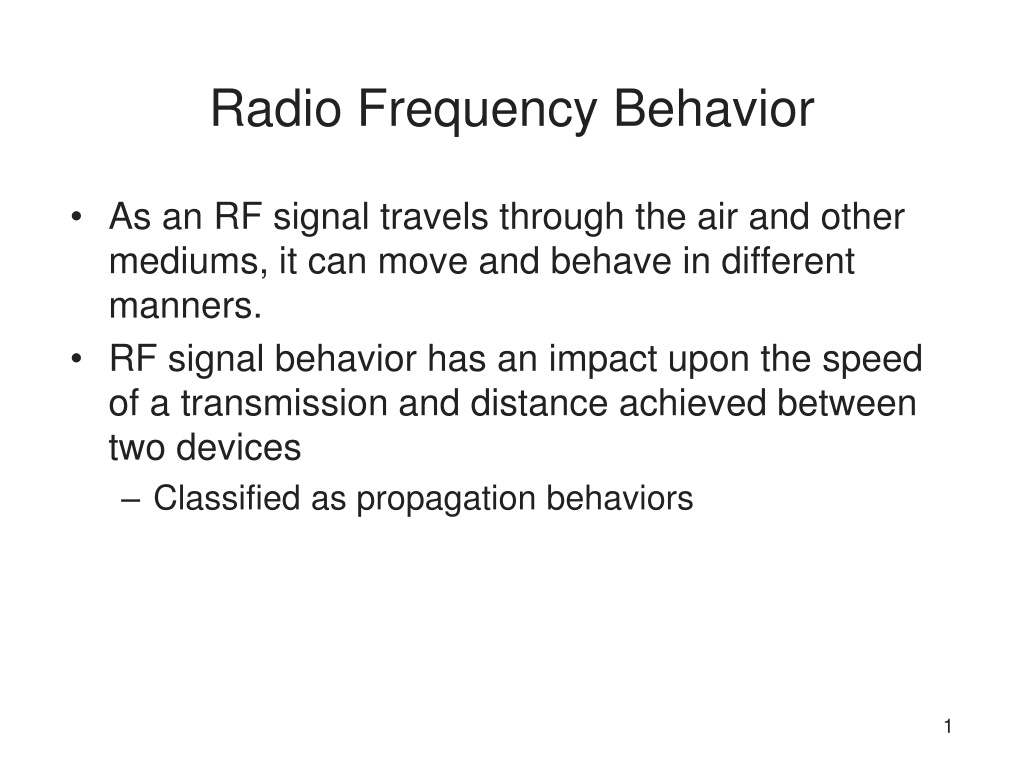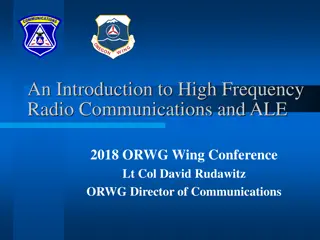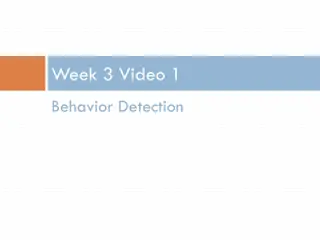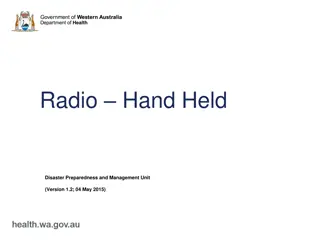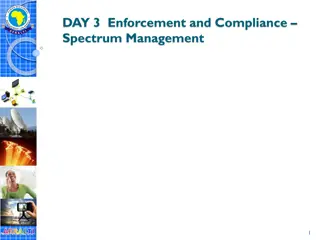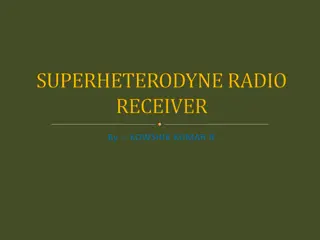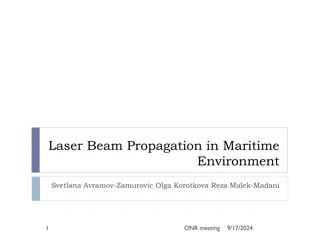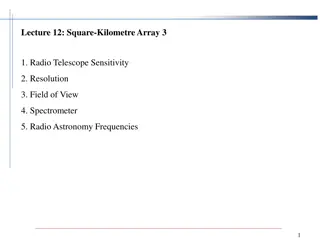Understanding Radio Frequency Behavior and Propagation Behaviors
Radio frequency signals exhibit various behaviors as they travel through different mediums, affecting transmission speed and distance between devices. Propagation behaviors include absorption, reflection, scattering, refraction, and diffraction, impacting wireless network performance. Understanding these behaviors is crucial for deploying access points, choosing the right antennas, and monitoring network performance.
Download Presentation

Please find below an Image/Link to download the presentation.
The content on the website is provided AS IS for your information and personal use only. It may not be sold, licensed, or shared on other websites without obtaining consent from the author. Download presentation by click this link. If you encounter any issues during the download, it is possible that the publisher has removed the file from their server.
E N D
Presentation Transcript
Radio Frequency Behavior As an RF signal travels through the air and other mediums, it can move and behave in different manners. RF signal behavior has an impact upon the speed of a transmission and distance achieved between two devices Classified as propagation behaviors 1
Propagation Behaviors Common misconception: an RF signal goes out from an antenna in a single signal that takes a direct path to a receiver. Signal may bounce off of walls and other objects Wave propagation: the way in which the signal travels Several different behaviors the wave will take: Absorption, reflection, scattering, refraction, and diffraction 2
Incorrect and correct views of wave propagation and multipath 3
Propagation Behaviors Understand RF propagation behaviors helps for: Making sure that access points are deployed in the proper location, Making sure the proper type of antenna is chosen Monitoring the performance of the wireless network. 4
Absorption The most common RF behavior is absorption, most materials will absorb some amount of an RF signal to varying degrees. Materials that will absorb the RF signal: Concrete, wood, and asphalt A 2.4 GHz signal will be 1/16 the original power after propagating through a concrete wall. That same signal will only lose one-half the original power after passing through drywall material. Absorption is a leading cause of attenuation (loss) 5
Reflection Reflection: when a signal is bounced off a smooth, nonabsorptive surface and change it direction Opposite of absorption Caused by objects that are very large and smooth (walls, buildings, and the surface of the earth) Objects made of metal will reflect a signal If not properly handled, reflections could cause a decrease in throughput and poor network performance in IEEE 802.11a/b/g wireless networks, because reflecting generate multiple reflected signals, this effect called multipath. 7
Scattering When an RF signal strikes an uneven surface, wavefronts of the signal will reflect off the uneven surface in several directions Scattering can most easily be described as multiple reflections. These multiple reflections occur when the electromagnetic signal s wavelength is larger than pieces of whatever medium the signal is reflecting from or passing through. Caused by small objects such as: foliage, rocks, and sand Can also occur when RF signal comes in contact with airborne substances such as rain or heavy dust 9
Scattering 10
Refraction When an RF signal moves from one medium to another of a different density the signal bends instead of traveling in a straight line Bending behavior is known as refraction Refraction 11
Diffraction Diffraction occurs when an object with rough surfaces is in the path of the RF signal ad causes it to bend Diffraction 12
Impact of Behaviors Attenuation: loss of signal strength or decrease its amplitude Two phenomena that can result in loss of an RF signal: Free Space Path Loss (FPSL): natural loss of signal strength through space Not a result of absorption, reflection, scattering, or diffraction Delay Spread: The difference in time of multipath signals that reach the receiver 13
Why Is Free Space Path Loss Important? All radio devices have what is known as a receive sensitivity level. The radio receiver can properly interpret and receive a signal down to a certain fixed amplitude threshold. If a radio receives a signal above its amplitude threshold, the signal is powerful enough for the radio to sense and interpret the signal. If the amplitude of a received signal is below the radio s receive sensitivity threshold, the radio can no longer properly sense and interpret the signal 14
Amplification Gain: Positive difference in amplitude between two signals The strengthening of a signal Achieved by amplification of signal Amplification in delay spread can occur if copies arrive at the same time as the primary signal and are in phase End result is that the signal is strengthened Known as upfade 15
RF Signal Strength Measurements Four units of measurements are used to represent RF signal strength: mW (milliwatts) dBm (decibel milliwatts) RSSI (Receive Signal Strength Indicator) Signal-to-Noise Ratio 16
Milliwatt (mW) Voltage: electrical pressure on a wire and is measured in volts Current: rate of electrical flow and is measured in amperes or amps Resistance: Impedance of electrical flow and is measured in ohms Electrical power: amount of energy and is measured in watts (W) A watt is a basic unit of power of 1 amp of current that flows at 1 volt Milliwatt (mW) is one thousandth of a watt of power 17
Decibel Milliwatt (dBm) RF power measured by two units on two scales: Linear scale: Using milliwatts (mW) Reference point is zero Does not reveal gain or loss in relation to whole Relative scale: Reference point is the measurement itself Often use logarithms Measured in decibels (dB) The reference point that relates the (dB) scale to the linear milliwatt scale is know as decibel milliwatt (dBm) 19
Receive Signal Strength Indicator (RSSI) RSSI: a mechanism by which RF signal strength can be measured by the circuitry on a wireless NIC Value was intended for internal use by the wireless NIC Example a wireless NIC can check the RSSI value to: Determine if it is clear to send its transmission Determine if the user is roaming beyond the range of a particular AP 20
WiFi signal strength is typically measured in decibel milliwatts (dBm), a unit of the level that is used to indicate that a power ratio is expressed in decibels (dB) with reference to one milliwatt (mW). 21
Signal-to-Noise Ratio SNR is the difference in decibels between the received signal and the background noise level. For example, if you receive a signal of -70 dBm and the noise floor is measured at 80 dBm, the SNR is 10 dB. Of course, you want the Signal-to-Noise ratio to be as high as possible so that it s less likely for a signal to disappear in environmental noise. 24
Signal-to-Noise Ratio Noise: unwanted interference that impacts the RF signal Signal-to-noise ratio (SNR): desired signal to undesired signal (noise) in the average power level of a transmission (given as dB) How SNR values relate to WLAN performance: Over 40 dB = Excellent signal (5 bars) 25 dB-40 dB = Very good signal (3-4 bars) 15 dB-25 dB =Low signal (2 bars) 10 dB-15 dB = Very low signal (1 bar) Less than 10 dB = No signal (0 bar) 26
Summary An analog signal is a continuous signal with no breaks in it A digital signal consists of data that is discrete or separate, as opposed to continuous Almost all wireless systems use digital modulations Four units of measurements are used to represent RF signal strength: mW (milliwatts), dBm (decibel milliwatts), RSSI (Receive Signal Strength Indicator), and SNR 28
If youre in the same room as your wireless router and have trouble achieving good network performance, the chances are that there is a lot of environmental noise from various electronic devices and other wireless networks. 29
Summary The behavior of the RF signal has a significant impact on the speed of the transmission and the distance between two devices Propagation behaviors include: Absorption, reflection, scattering, refraction, and diffraction Loss of signal strength is known as attenuation Free space path loss is the natural loss of signal strength through space The difference in time of multipath signals that reach the receiver is known as delay spread 30
